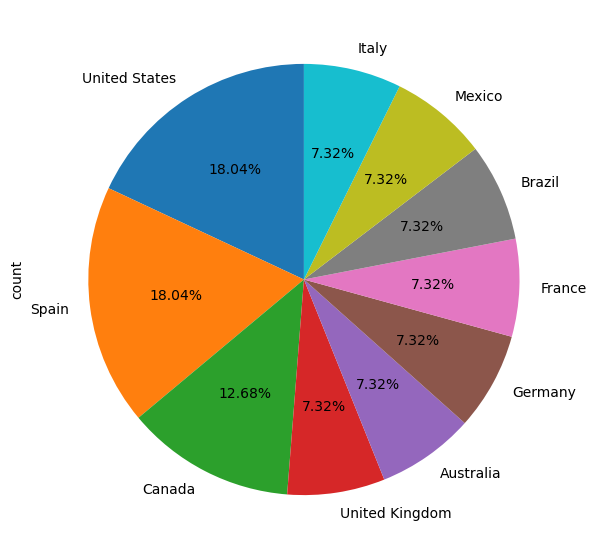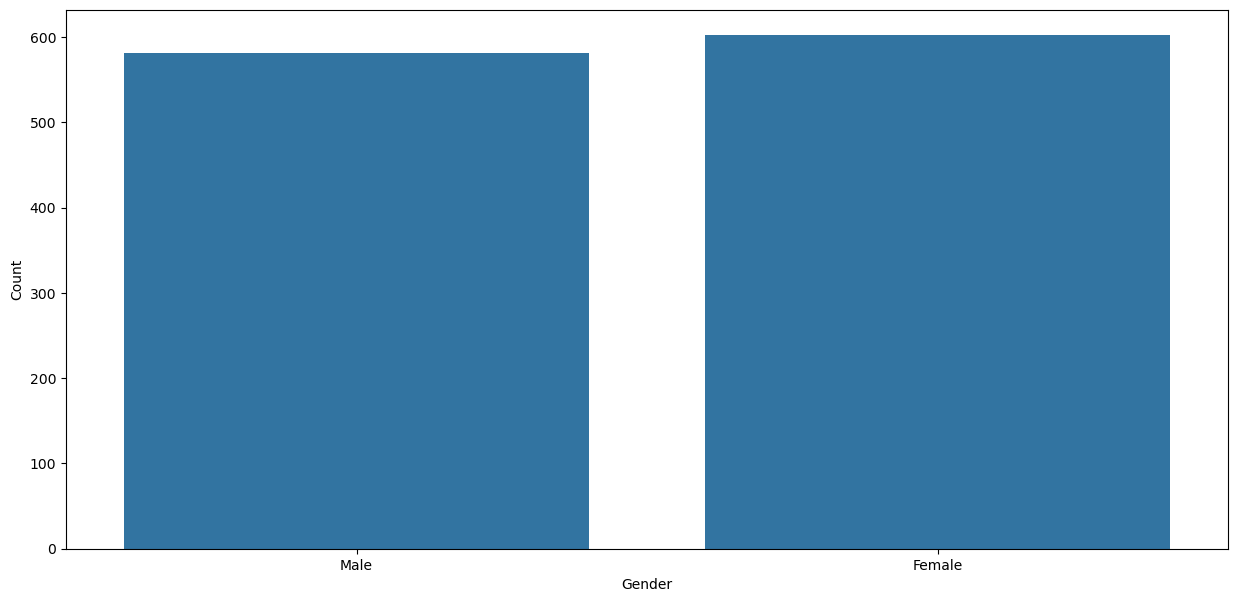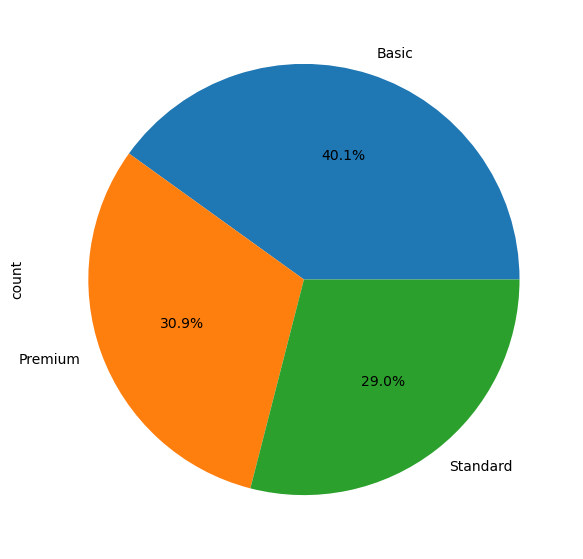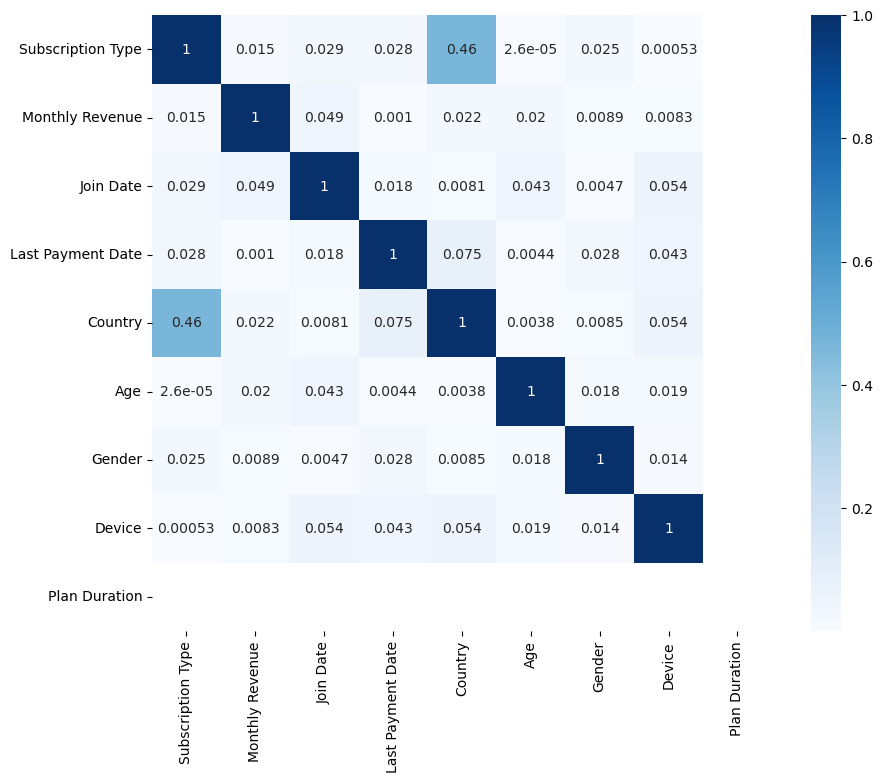Netflix User Data
L’ensemble de données fu fichier Netflix_Userbase.csv fournit un aperçu d’un échantillon d’utilisateurs de Netflix.
Chaque ligne représente un utilisateur unique, identifié par son ID utilisateur.
L’ensemble de données comprend les colonnes suivantes :
- le type d’abonnement de l’utilisateur (Basic, Standard ou Premium),
- le revenu mensuel généré par son abonnement,
- la date d’inscription à Netflix,
- la date de son dernier paiement et
- le pays dans lequel il se trouve.
Des colonnes supplémentaires ont été incluses pour fournir des informations sur le comportement et les préférences des utilisateurs, comme le type d’appareil.
Source : Kaggle
Disclaimer: l’ensemble de données sert de représentation synthétique et ne reflète pas les données réelles des utilisateurs de Netflix. Il peut être utilisé à des fins d’analyse et de modélisation pour comprendre les tendances des utilisateurs, leurs préférences et la génération de revenus au sein d’une base d’utilisateurs hypothétique de Netflix.
1 Exercice
- Affichages
- Charger le fichier
Netflix_Userbase.csvdans un DataFrame. - Afficher les 20 premières lignes.
- Combien de ligne et de colonnes contient ce fichier ?
- Quels sont les types des colonnes ?
- Pour chaque colonnes, combien de valeurs différentes contient-elle ?
- Y a-t-il des valeurs manquantes ?
- Charger le fichier
- Modification des données
- Ne garder que les utilisateurs europeens.
- Aggregations/Visualisations
- Afficher le nombre d’utilisateurs par pays.
- Afficher le nombre d’utilisateurs par sexe.
- Afficher le nombre d’utilisateurs par devices utilisés.
- Continuer l’analyse des données en affichant des visualisations qui vous semblent pertinentes en combinant les différentes caractéristiques des utilisateurs.
- Conclusion
- Quels sont les insights que vous avez pu tirer de cette analyse ?
1.1 Affichages
| User ID | Subscription Type | Monthly Revenue | Join Date | Last Payment Date | Country | Age | Gender | Device | Plan Duration | |
|---|---|---|---|---|---|---|---|---|---|---|
| 0 | 1 | Basic | 10 | 15-01-22 | 10-06-23 | United States | 28 | Male | Smartphone | 1 Month |
| 1 | 2 | Premium | 15 | 05-09-21 | 22-06-23 | Canada | 35 | Female | Tablet | 1 Month |
| 2 | 3 | Standard | 12 | 28-02-23 | 27-06-23 | United Kingdom | 42 | Male | Smart TV | 1 Month |
| 3 | 4 | Standard | 12 | 10-07-22 | 26-06-23 | Australia | 51 | Female | Laptop | 1 Month |
| 4 | 5 | Basic | 10 | 01-05-23 | 28-06-23 | Germany | 33 | Male | Smartphone | 1 Month |
| 5 | 6 | Premium | 15 | 18-03-22 | 27-06-23 | France | 29 | Female | Smart TV | 1 Month |
| 6 | 7 | Standard | 12 | 09-12-21 | 25-06-23 | Brazil | 46 | Male | Tablet | 1 Month |
| 7 | 8 | Basic | 10 | 02-04-23 | 24-06-23 | Mexico | 39 | Female | Laptop | 1 Month |
| 8 | 9 | Standard | 12 | 20-10-22 | 23-06-23 | Spain | 37 | Male | Smartphone | 1 Month |
| 9 | 10 | Premium | 15 | 07-01-23 | 22-06-23 | Italy | 44 | Female | Smart TV | 1 Month |
| 10 | 11 | Basic | 10 | 16-05-22 | 22-06-23 | United States | 31 | Female | Smartphone | 1 Month |
| 11 | 12 | Premium | 15 | 23-03-23 | 28-06-23 | Canada | 45 | Male | Tablet | 1 Month |
| 12 | 13 | Standard | 12 | 30-11-21 | 27-06-23 | United Kingdom | 48 | Female | Laptop | 1 Month |
| 13 | 14 | Basic | 10 | 01-08-22 | 26-06-23 | Australia | 27 | Male | Smartphone | 1 Month |
| 14 | 15 | Standard | 12 | 09-05-23 | 28-06-23 | Germany | 38 | Female | Smart TV | 1 Month |
| 15 | 16 | Premium | 15 | 07-04-22 | 27-06-23 | France | 36 | Male | Tablet | 1 Month |
| 16 | 17 | Basic | 10 | 24-01-22 | 25-06-23 | Brazil | 30 | Female | Laptop | 1 Month |
| 17 | 18 | Standard | 12 | 18-10-21 | 24-06-23 | Mexico | 43 | Male | Smartphone | 1 Month |
| 18 | 19 | Premium | 15 | 15-02-23 | 23-06-23 | Spain | 32 | Female | Smart TV | 1 Month |
| 19 | 20 | Basic | 10 | 27-05-23 | 22-06-23 | Italy | 41 | Male | Tablet | 1 Month |
<class 'pandas.core.frame.DataFrame'>
RangeIndex: 2500 entries, 0 to 2499
Data columns (total 10 columns):
# Column Non-Null Count Dtype
--- ------ -------------- -----
0 User ID 2500 non-null int64
1 Subscription Type 2500 non-null object
2 Monthly Revenue 2500 non-null int64
3 Join Date 2500 non-null object
4 Last Payment Date 2500 non-null object
5 Country 2500 non-null object
6 Age 2500 non-null int64
7 Gender 2500 non-null object
8 Device 2500 non-null object
9 Plan Duration 2500 non-null object
dtypes: int64(3), object(7)
memory usage: 195.4+ KBNotre jeu de données contient 2500 lignes (= utilisateurs) et 12 colonnes. 3 colonnes sont de type int, 7 colonnes sont de type object. Notons que les colonnes date sont de type object et devront être converties en datetime pour être exploitées correctement le cas échéant.
Statistiques descriptives pour les colonnes numériques :
| User ID | Monthly Revenue | Age | |
|---|---|---|---|
| count | 2500.00000 | 2500.000000 | 2500.000000 |
| mean | 1250.50000 | 12.508400 | 38.795600 |
| std | 721.83216 | 1.686851 | 7.171778 |
| min | 1.00000 | 10.000000 | 26.000000 |
| 25% | 625.75000 | 11.000000 | 32.000000 |
| 50% | 1250.50000 | 12.000000 | 39.000000 |
| 75% | 1875.25000 | 14.000000 | 45.000000 |
| max | 2500.00000 | 15.000000 | 51.000000 |
Statistiques descriptives pour les colonnes catégorielles :
| Subscription Type | Join Date | Last Payment Date | Country | Gender | Device | Plan Duration | |
|---|---|---|---|---|---|---|---|
| count | 2500 | 2500 | 2500 | 2500 | 2500 | 2500 | 2500 |
| unique | 3 | 300 | 26 | 10 | 2 | 4 | 1 |
| top | Basic | 05-11-22 | 28-06-23 | United States | Female | Laptop | 1 Month |
| freq | 999 | 33 | 164 | 451 | 1257 | 636 | 2500 |
Pour les colonnes dont les valeurs uniques sont inférieures à 20, afficher les possibilités de ces valeurs.
for c in df_complet.columns:
if df_complet[c].nunique() < 20:
print(f"{c:.<20}", sorted(df_complet[c].unique()))Subscription Type... ['Basic', 'Premium', 'Standard']
Monthly Revenue..... [10, 11, 12, 13, 14, 15]
Country............. ['Australia', 'Brazil', 'Canada', 'France', 'Germany', 'Italy', 'Mexico', 'Spain', 'United Kingdom', 'United States']
Gender.............. ['Female', 'Male']
Device.............. ['Laptop', 'Smart TV', 'Smartphone', 'Tablet']
Plan Duration....... ['1 Month']masque = [col for col in df_complet.columns if df_complet[col].nunique() < 20]
for col in masque:
# display(df_complet[col].value_counts())
# plus joli
display(pd.DataFrame(df_complet[col].value_counts()).sort_index())| count | |
|---|---|
| Subscription Type | |
| Basic | 999 |
| Premium | 733 |
| Standard | 768 |
| count | |
|---|---|
| Monthly Revenue | |
| 10 | 409 |
| 11 | 388 |
| 12 | 455 |
| 13 | 418 |
| 14 | 431 |
| 15 | 399 |
| count | |
|---|---|
| Country | |
| Australia | 183 |
| Brazil | 183 |
| Canada | 317 |
| France | 183 |
| Germany | 183 |
| Italy | 183 |
| Mexico | 183 |
| Spain | 451 |
| United Kingdom | 183 |
| United States | 451 |
| count | |
|---|---|
| Gender | |
| Female | 1257 |
| Male | 1243 |
| count | |
|---|---|
| Device | |
| Laptop | 636 |
| Smart TV | 610 |
| Smartphone | 621 |
| Tablet | 633 |
| count | |
|---|---|
| Plan Duration | |
| 1 Month | 2500 |
1.2 Modification des données
User ID est une colonne qui ne sert pas à grand chose, on peut la supprimer.
filtre = ['United Kingdom', 'Germany', 'France', 'Spain', 'Italy']
# mask = (df_complet['Country'] in filtre) # erreur
# mask = df_complet['Country']==filtre[0] | df_complet['Country']==filtre[1] | df_complet['Country']==filtre[2] | df_complet['Country']==filtre[3] | df_complet['Country']==filtre[4] # erreur
mask = df_complet['Country'].isin(filtre)
df = df_complet[mask]
df| Subscription Type | Monthly Revenue | Join Date | Last Payment Date | Country | Age | Gender | Device | Plan Duration | |
|---|---|---|---|---|---|---|---|---|---|
| 2 | Standard | 12 | 28-02-23 | 27-06-23 | United Kingdom | 42 | Male | Smart TV | 1 Month |
| 4 | Basic | 10 | 01-05-23 | 28-06-23 | Germany | 33 | Male | Smartphone | 1 Month |
| 5 | Premium | 15 | 18-03-22 | 27-06-23 | France | 29 | Female | Smart TV | 1 Month |
| 8 | Standard | 12 | 20-10-22 | 23-06-23 | Spain | 37 | Male | Smartphone | 1 Month |
| 9 | Premium | 15 | 07-01-23 | 22-06-23 | Italy | 44 | Female | Smart TV | 1 Month |
| ... | ... | ... | ... | ... | ... | ... | ... | ... | ... |
| 2490 | Premium | 13 | 18-07-22 | 11-07-23 | France | 41 | Female | Smartphone | 1 Month |
| 2493 | Premium | 12 | 21-07-22 | 15-07-23 | Spain | 36 | Male | Smart TV | 1 Month |
| 2494 | Basic | 15 | 23-07-22 | 12-07-23 | Italy | 43 | Female | Laptop | 1 Month |
| 2495 | Premium | 14 | 25-07-22 | 12-07-23 | Spain | 28 | Female | Smart TV | 1 Month |
| 2496 | Basic | 15 | 04-08-22 | 14-07-23 | Spain | 33 | Female | Smart TV | 1 Month |
1183 rows × 9 columns
1.3 Aggregations/Visualisations
Country
Spain 451
United Kingdom 183
Germany 183
France 183
Italy 183
Name: count, dtype: int64Bar plot : Gender distribution
pd.DataFrame({ 'Nombre': df['Gender'].value_counts(),
'Pourcentage (%)': df['Gender'].value_counts(normalize=True)
})| Nombre | Pourcentage (%) | |
|---|---|---|
| Gender | ||
| Female | 602 | 0.508876 |
| Male | 581 | 0.491124 |
Bar plot : Age group distribution
pd.DataFrame({ 'Nombre': df['Device'].value_counts(),
'Pourcentage (%)': df['Device'].value_counts(normalize=True)
})| Nombre | Pourcentage (%) | |
|---|---|---|
| Device | ||
| Laptop | 316 | 0.267117 |
| Smart TV | 297 | 0.251057 |
| Smartphone | 286 | 0.241758 |
| Tablet | 284 | 0.240068 |
Pie chart : Subscription type
pd.DataFrame({ 'Nombre': df['Subscription Type'].value_counts(),
'Pourcentage (%)': df['Subscription Type'].value_counts(normalize=True)
})| Nombre | Pourcentage (%) | |
|---|---|---|
| Subscription Type | ||
| Basic | 474 | 0.400676 |
| Premium | 366 | 0.309383 |
| Standard | 343 | 0.289941 |
Bar plot : Subscription Type by Gender
# pd.crosstab(df['Subscription Type'], df['Gender']) # tableau de contingence
# pd.crosstab(df['Subscription Type'], df['Gender'], normalize='index') # pourcentage par ligne
# pd.crosstab(df['Subscription Type'], df['Gender'], normalize='columns') # pourcentage par colonne
pd.crosstab(df['Subscription Type'], df['Gender'], normalize='all') # pourcentage total| Gender | Female | Male |
|---|---|---|
| Subscription Type | ||
| Basic | 0.207101 | 0.193576 |
| Premium | 0.161454 | 0.147929 |
| Standard | 0.140321 | 0.149620 |
pd.pivot_table(df, index='Country', columns=['Gender','Device'], values='Subscription Type', aggfunc='count')| Gender | Female | Male | ||||||
|---|---|---|---|---|---|---|---|---|
| Device | Laptop | Smart TV | Smartphone | Tablet | Laptop | Smart TV | Smartphone | Tablet |
| Country | ||||||||
| France | 29 | 25 | 24 | 13 | 23 | 18 | 23 | 28 |
| Germany | 27 | 26 | 17 | 24 | 36 | 16 | 19 | 18 |
| Italy | 20 | 31 | 20 | 20 | 30 | 15 | 27 | 20 |
| Spain | 56 | 63 | 49 | 65 | 51 | 63 | 53 | 51 |
| United Kingdom | 22 | 16 | 27 | 28 | 22 | 24 | 27 | 17 |
for i,c in enumerate(['Gender','Device']):
plt.subplot(1,2,i+1)
sns.countplot(data=df, x=c, hue='Subscription Type');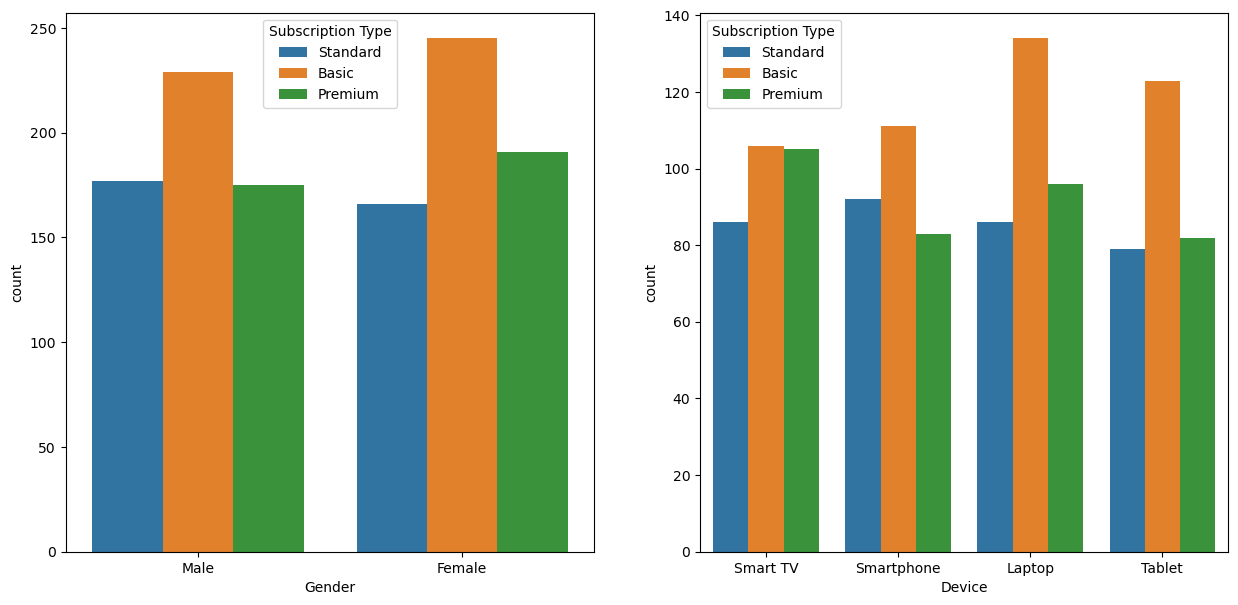
Index(['Subscription Type', 'Join Date', 'Last Payment Date', 'Country',
'Gender', 'Device', 'Plan Duration'],
dtype='object')
